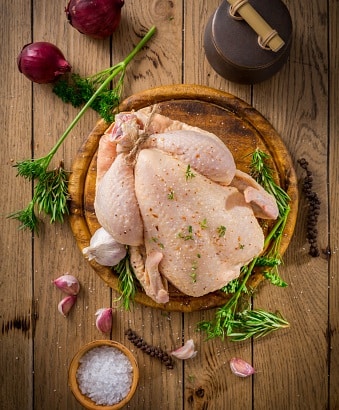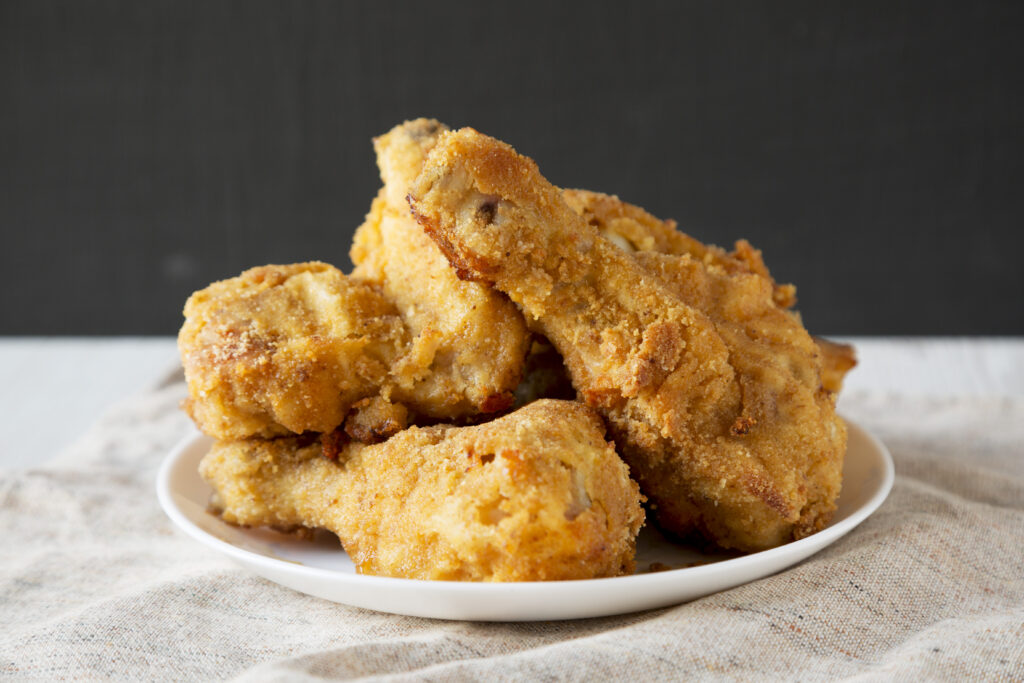

Chicken can sometimes be tricky to prepare and cook properly. Here are common mistakes people make when prepping and cooking this popular poultry and the correct way to do them.
Don’t: Cook cold chicken straight from the fridge.
Ice-cold chicken straight from the fridge doesn’t cook as evenly as room-temperature meat.
Do: Place chicken in a bowl and leave on the counter for 15-25 minutes before cooking, depending on size and cuts.
Don’t: Thaw frozen chicken on the counter or under running water.
The outside of a chicken warms more quickly than its interior. Thawing it for several hours at room temperature risks foodborne bacteria growth. The same goes when thawing under running warm or room-temperature water; salmonella or bacteria may develop.
Do: Thaw frozen chicken in a large bowl on the bottom shelf of your fridge up to two days before you plan to cook it. It will defrost at an even temperature.
Don’t: Rinse chicken before cooking.
Rinsing or soaking your chicken will not kill bacteria. Doing so may cause bacteria to contaminate your work surface, utensils, sink, or other food.
Do: Pat chicken dry with paper towels. The heat when cooking will kill any bacteria.
Don’t: Leave chicken on an open grill.
Moisture will evaporate causing your chicken to become stringy and overcooked.
Do: Keep the grill lid closed for at least 5 to 8 minutes at a time. You can peek at your chicken as it is grilling. Closing the grill creates convection heat to cook the chicken more evenly from all angles.
Don’t: Remove chicken skin with your hands.
This can damage the chicken and raise your risk for foodborne illness. It’s easy to accidentally tear through the meat or touch your cooking tool or cutting board with contaminated hands.
Do: Use a sharp, small paring knife to remove the skin evenly.
Don’t: Over-Marinate
When a marinade contains citrus, such as lemon, lime, or orange juice, the citric acid breaks down the meat over time, making it mushy when cooked.
Do: Marinate for two hours when using citrus in a plastic bag or container. When using yogurt or buttermilk, marinate for no longer than a day so the lactic acid won’t over-tenderize the chicken.
Don’t: Cook or Saute whole chicken breasts on high heat
Chicken breasts are thicker on one side and much narrower on the other. One side may dry out while the other side is undercooked if the heat is too high.
Do: Pound raw chicken breasts into an even thickness and cook over medium-low heat so it cooks evenly.
Don’t: Skip checking the temperature of the oil for fried chicken.
If your oil is not at the correct temperature when you add your chicken, it can be undercooked with a soggy crust.

Do: Use a thermometer to check that the temperature of the oil is 300 to 325 degrees F. Add the chicken and adjust the heat to make sure the oil stays at 300 degrees F the entire time to ensure crisp, evenly cooked fried chicken.
Don’t: Under-season chicken
If you don’t salt your chicken generously it will be bland with soggy skin. Salt helps roasted chicken develop a crispy, browned skin and builds flavor.
Do: Generously salt and pepper the chicken, inside and out if you are roasting a whole bird.
Don’t: Crowd your skillet or pan
When chicken pieces are overlapping or touching, they are hard to move and will not cook evenly. Overcrowding will not crisp up the skin.
Do: Pat chicken dry and use a large skillet so that pieces aren’t touching. Coat the pan with oil and heat on medium. Do not disturb the chicken while cooking the first side. When chicken is browned on one side, flip and brown the other side. If you flip too quickly, however, the skin may tear and result in under-seasoned and unevenly cooked chicken.
Don’t: Cut your chicken to check if it is cooked
Some parts of chicken cook faster than others, so checking the juices in one section doesn’t mean the entire chicken is ready. Also, you may mangle your chicken.
Do: Invest in a good meat thermometer. Check the chicken on the thickest part to make sure the internal temperature is 165 degrees F.
Don’t: Not resting your roasted chicken
The juices need time to settle back into the meat or they will leak out onto your cutting board and your chicken will be dry.
Do: After transferring to a board, tent the bird loosely with foil and let rest for 15 minutes before cutting.
Always be safe when handling raw chicken and practice the methods for prepping and cooking your chicken. These proven tips will guarantee your chicken dish will be the tastiest and best it can be.
If you can't find an item you're searching for, let us know! We're always looking for ways to improve your Food Town experience, and we'll do our best to make that product available. Make a suggestion
29 Houston-Area Locations